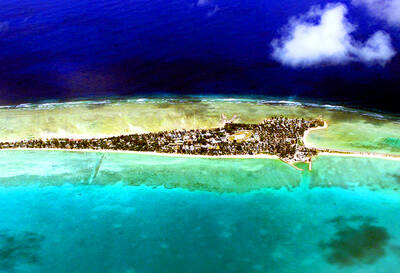Scientists have discovered a more efficient way of building a synthetic genome that could one day enable them to create artificial life, a study released on Wednesday said.
The method is already being used to help develop next generation biofuels and biochemicals in the labs of controversial celebrity US scientist Craig Venter. Venter has hailed artificial life forms as a potential remedy to illness and global warming, but the prospect is highly controversial and arouses heated debate over its potential ramifications and the ethics of engineering artificial life.
Artificially engineered life is one of the Holy Grails of science, but also stirs deep fears as foreseen in Aldous Huxley’s 1932 novel Brave New World, in which natural human reproduction is eschewed in favor of babies grown in laboratories.
The J. Craig Venter Institute succeeded in synthetically reproducing the DNA of a simple bacterium last year. The researchers had initially used the bacterium E. coli to build the genome, but found it was a tedious, multi-stage process and that E. coli had difficulty reproducing large DNA segments.
They eventually tried using a type of yeast called Saccharomyces cerevisiae. This enabled them to finish creating the synthetic genome using a method called homologous recombination, a process that cells naturally use to repair damage to their chromosomes.
They then began to explore the capacity for DNA assembly in yeast, which turned out to be a “genetic factory,” the institute said in a statement on Wednesday.
Researchers inserted relatively short segments of DNA fragments into yeast cells through a mehomologous recombination method.
They found they were able to build the entire genome in one step, said the study, set to be published in Proceedings of the National Academy of Sciences.
“We continue to be amazed by the capacity of yeast to simultaneously take up so many DNA pieces and assemble them into genome-size molecules,” lead author Daniel Gibson said. “This capacity begs to be further explored and extended and will help accelerate progress in applications of synthetic genomics.”
Senior author Clyde Hutchison said: “I am astounded by our team’s progress in assembling large DNA molecules. It remains to be seen how far we can push this yeast assembly platform but the team is hard at work exploring these methods as we work to boot up the synthetic chromosome.”
Venter and his team continue to work towards creating a living bacterial cell using the synthetic genome sequence of the Mycoplasma genitalium bacterium.
The bacterium, which causes certain sexually transmitted diseases, has one of the least complex DNA structures of any life form, composed of just 580 genes.
In contrast, the human genome has some 30,000.
Using the genetic sequence of this bacterium, the Maryland-based team has created a chromosome known as Mycoplasma laboratorium.
They are working on developing a way to transplant this chromosome into a living cell and stimulate it to take control and effectively become a new life form.

DISASTER: The Bangladesh Meteorological Department recorded a magnitude 5.7 and tremors reached as far as Kolkata, India, more than 300km away from the epicenter A powerful earthquake struck Bangladesh yesterday outside the crowded capital, Dhaka, killing at least five people and injuring about a hundred, the government said. The magnitude 5.5 quake struck at 10:38am near Narsingdi, Bangladesh, about 33km from Dhaka, the US Geological Survey (USGS) said. The earthquake sparked fear and chaos with many in the Muslim-majority nation of 170 million people at home on their day off. AFP reporters in Dhaka said they saw people weeping in the streets while others appeared shocked. Bangladesh Interim Leader Muhammad Yunus expressed his “deep shock and sorrow over the news of casualties in various districts.” At least five people,

ON THE LAM: The Brazilian Supreme Court said that the former president tried to burn his ankle monitor off as part of an attempt to orchestrate his escape from Brazil Former Brazilian president Jair Bolsonaro — under house arrest while he appeals a conviction for a foiled coup attempt — was taken into custody on Saturday after the Brazilian Supreme Court deemed him a high flight risk. The court said the far-right firebrand — who was sentenced to 27 years in prison over a scheme to stop Brazilian President Luiz Inacio Lula da Silva from taking office after the 2022 elections — had attempted to disable his ankle monitor to flee. Supreme Court judge Alexandre de Moraes said Bolsonaro’s detention was a preventive measure as final appeals play out. In a video made

It is one of the world’s most famous unsolved codes whose answer could sell for a fortune — but two US friends say they have already found the secret hidden by Kryptos. The S-shaped copper sculpture has baffled cryptography enthusiasts since its 1990 installation on the grounds of the CIA headquarters in Virginia, with three of its four messages deciphered so far. Yet K4, the final passage, has kept codebreakers scratching their heads. Sculptor Jim Sanborn, 80, has been so overwhelmed by guesses that he started charging US$50 for each response. Sanborn in August announced he would auction the 97-character solution to K4

SHOW OF FORCE: The US has held nine multilateral drills near Guam in the past four months, which Australia said was important to deter coercion in the region Five Chinese research vessels, including ships used for space and missile tracking and underwater mapping, were active in the northwest Pacific last month, as the US stepped up military exercises, data compiled by a Guam-based group shows. Rapid militarization in the northern Pacific gets insufficient attention, the Pacific Center for Island Security said, adding that it makes island populations a potential target in any great-power conflict. “If you look at the number of US and bilateral and multilateral exercises, there is a lot of activity,” Leland Bettis, the director of the group that seeks to flag regional security risks, said in an